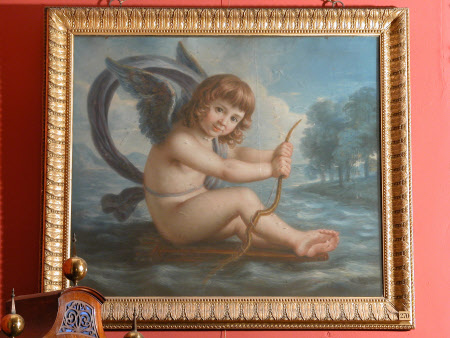Henry Merrick Hoare (1770-1856) or Sir Henry Hugh Hoare, 3rd Bt (1762-1841) as Cupid rowing with his bow on his quiver
William Hoare of Bath, RA (Eye 1707 – Bath 1792)
Category
Art / Drawings and watercolours
Date
1707 - 1792
Materials
Pastel on paper
Measurements
767 x 895 mm
Order this imageCollection
Stourhead, Wiltshire
NT 730779
Summary
Pastel on paper, Henry Merrick Hoare (1770-1856) or Sir Henry Hugh Hoare, 3rd Bt (1762-1841) as Cupid rowing with his bow on his quiver by William Hoare of Bath, RA (Eye 1707 – Bath 1792). Henry Merrik Hoare was the fourth son of Sir Richard Hoare, 1st Bt. (1734/5 – 1787) of Barn Elms, the third by his second wife, Frances Ann Acland. He married in 1807 Sophia Thrale (d.1824), daughter of the brewer Henry Thrale and his wife Hester (later Piozzi), Samuel Johnson’s friends and patrons, but left no issue. Despite previous doubts that this might have shown Henry Hugh, rather than Henry Merrik Hoare, the realisation of the probability that this is the picture that was exhibited at the R.A. in 1772 makes it almost certain that the traditional identification as Henry Merrik Hoare is the right one. Evelyn Newby had already suggested that the unusual composition was derived from a – possibly pseudo – Antique gem. It was, however, Simon McKeown, a master at Marlborough College, who recognised it as deriving from an emblem by Otto Vaenius, Otto van Veen (1556-1629), of Cupid on his quiver, rowing with his bow: Via nulla est invia Amori - ‘no way is barred to love’ (Vaenius, Amorum emblemata figures aeneis incise, Antwerp, 1608, pp.92-93; also Raphael Custos, Emblemata amoris consecrata, Augsburg, 1622, vol.I, p.45: cf. Henkel & Schöne, Emblemata, 1967/1996, col.1763) – altogether, a somewhat curious emblem for an actual baby boy to be the incarnation of!
Makers and roles
William Hoare of Bath, RA (Eye 1707 – Bath 1792)
